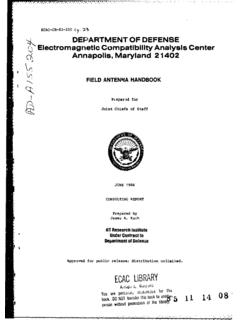Transcription of Introduction to the Electromagnetic Spectrum
1 Introduction to the Electromagnetic SpectrumEditor: Daniel FinkenthalWritten by: Daniel Finkenthal Beverly Greco Rick Halsey Lori Pena Steve Rodecker Billy Simms Rick L. Lee John Lohr Mike J. Schaffer David P. SchisselQTYUIOPThe Electromagnetic SpectrumContentsiiiTable of ContentsIntroduction Instructor/Student 1 The Visible Electromagnetic Spectrum .. 1 .. 7 2 Invisible Regions of the Electromagnetic Spectrum .. 9 ..13 Visible Light 3a Why Are There Colors in a Compact Disk? ..15 ..17 3b The Compact Disk as Diffraction Grating.
2 15 ..19 4 Measuring Wavelengths of Light ..21 ..23 5 Young s Experiment ..25 ..27 Sunlight 6 Blue Skies and Red Sunsets ..29 ..31 ..37 Infra-Red Radiation 8 Infrared Radiation and the Inverse-Square ..41 9 Detecting Infrared Radiation Using a Prism ..39 ..4310a Investigation of IR Light Using an IR Transmitter and Receiver ..45 ..4710b Investigation of IR Light Using a Close Circuit TV Camera ..45 ..49 Ultra-Violet Radiation11 Fluorescence ..51 ..5312UV Light Detection ..55 ..5713 Investigating the Absorption of UV Light by Oxygen.
3 55 ..5916 The Effect of UV Light on Yeast ..61 ..6315 The Effect of UV Light on DNA ..65 ..6716 Which Wavelength Causes Photogray Lenses to Change Color?..69 ..7117 Which Wavelength Causes Sunrez to Solidify? .. and Micro-Waves18 Measuring the Length of Radio Waves ..77 ..7919 Tuning Into Radio Waves ..77 ..8120 The Shielding of Radio Waves by Metal ..77 ..8321 Using the Earth s Ionosphere to Reflect Radio ..8522A Diffraction Grating for Radio Waves ..77 ..8723A Diffraction Grating for Microwaves ..77 ..89 ContentsThe Electromagnetic SpectrumOverviewcontinuedCurriculum Overview: Introduction to theElectromagnetic SpectrumIn the matter of physics, the first lessons should contain nothing but what isexperimental and interesting to see.
4 A pretty experiment is in itself often morevaluable than 20 formulae extracted from our minds; it is particularly important thata young mind that has yet to find its way about in the world of phenomena should bespared from formulae altogether. Albert EinsteinOverviewThis section focuses on activities that help students understand the Electromagnetic Spectrum , oneof the six stations on the DIII-D Tokamak Fusion Facility tour at General Atomics in San Diego, The goal is to help teachers teach the often difficult concepts related to the electro-magnetic Spectrum as well as prepare students for the tour.
5 This section contains a number of more orless informal laboratory units including demonstrations, experiments, and activities that are unlikelyto be found in traditional science textbooks or lab manuals. Each unit contains an Instructor s Guideand a master copy of a Student Activity Sheet to be reproduced and distributed to each studentparticipating in the StatementThe curriculum contained here was developed by local teachers and scientists working together toimprove the state of science education in today s schools.
6 The aim is to increase the understandingand enthusiasm for science in high-schools through the use of more enlightening, empowering, andsocially relevant curriculum. We hope to help students understand and master the technological worldaround them in order to increase their own sense of power and control over their lives. By increasingunderstanding we seek to reduce the mystification, powerlessness and alienation of people fromscience, and eliminate the sense of elitism associated with science. These are lofty goals, and we hopeto rise to the curriculum units have been grouped into six different sections depending on their respectiveemphasis.
7 These sections are named as follows: Introduction Infrared Radiation Visible Light Ultraviolet Light Sunlight Radio and MicrowavesA complete listing of the units in each section is given in the Table of Contents that collective meetings and discussions with teachers at various levels, an optimized format forpresenting each curriculum unit was devised. Each unit includes a master copy of a single double-sided Student Activity Sheet, organized according to the table below. It was decided early on torestrain each Activity Sheet to a single double sided page since many teachers feel that anymoreoverwhelms the student or tends to get lost in the hustle, bustle, and shuffle of a typical school day.
8 Each Student Activity Sheet is accompanied with an Instructor s Guide. The Instructor s Guidecontains stated goals and objectives along with background information, helpful hints and availableresources, and ideas for further investigation. In most cases a complete description of each unit iscontained in the Student Activity Sheet, while the Instructors Guide is intended to serve as an aid forthe instructor organizing the activity at hand. In the case of laboratory demonstrations, however, thebulk of the material is contained in the Instructor s master copy for reproduction of each Student Activity Sheet directly follows each Instructor sGuide unit.
9 A second set of Student Activity Sheets are also grouped together in a separatelyorganized Student Activity Handbook. Teachers may wish to have the handbook duplicated as Overview: Introduction to the Electromagnetic SpectrumTable 1 Organizational format of each curriculum unit Instructor s Guide: Student Activity Sheet: GoalsPurposeObjectivesRequired EquipmentBackground InformationDiscussionHelpful HintsReview QuestionsExtensionsProcedureReferencesAn alysis QuestionsResource BoxA Resource Box containing the more unusual, expensive, or hard-to-obtain items involved in eachof the Activity Units has been developed and assembled by the DIII D Tokamak Fusion group to bedistributed with this Curriculum.
10 The more common classroom items such as an overhead projector,paper, tape, etc. are assumed to be available and will not be included in the Resource Box. Since theavailability of many materials varies with each school, please evaluate the Required Equipment andSupplies list in each activity and note what is and is not available at your Resource Boxes have been assembled and placed at different San Diego county schools tofacilitate distribution to local teachers. Each of these participating schools is charges with loaning andmaintaining an individual Resource Box.




![ܦ sl · è ¡«¼õ |¡u)ªkÞ} w&]R ÍÛ ÑÆ <®b?=u ä,| äõá](/cache/preview/5/5/e/b/3/c/4/4/thumb-55eb3c44cb92ba36f4e7b397c3da0322.jpg)